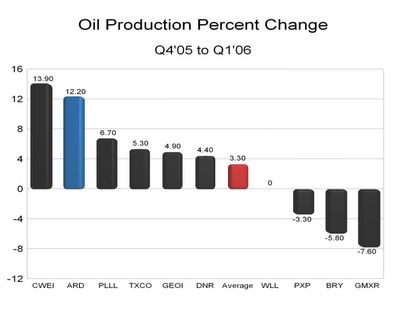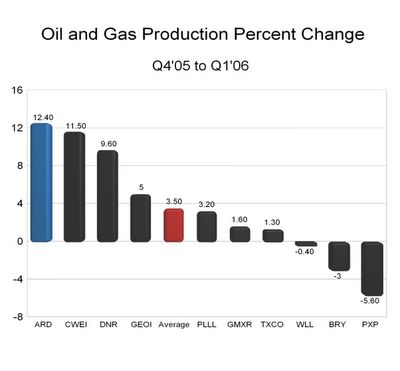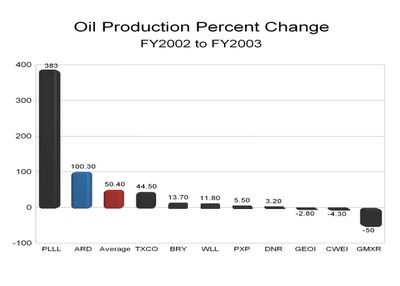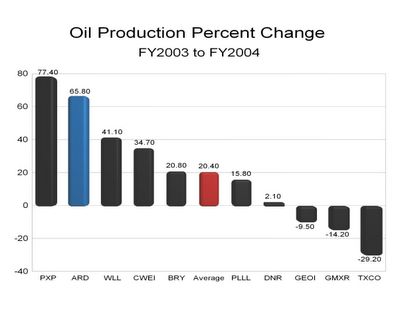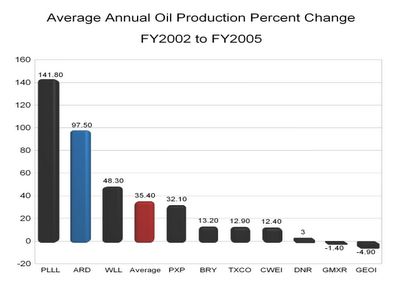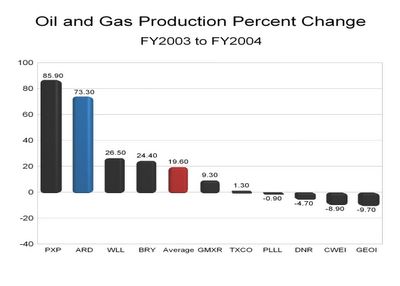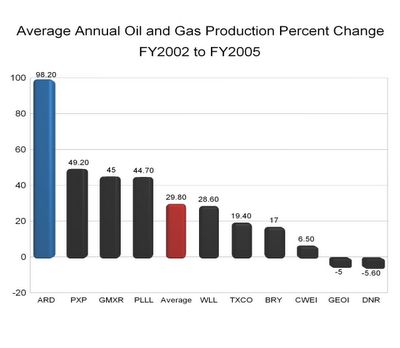Suntrust initiates Coverage on ARD with Neutral Rating and $31 Target PriceTry "Googling"
'Suntrust Robinson.' The first entry leads you to the
Suntrust website. While you're there just click on "Research Disclosures" and then click on
ARD.
Looks like Suntrust has ARD target price of $31. To come up with a target of $31 in my mind says they are lowballing price of crude, possibly lowballing production estimates, and not taking into account oil assets per share, superior cost structure, superior EBIT per BOE produced, superior operating margin, superior production growth and true NAV per share. In previous C.C. Tim stated that ARD has over $52 in NAV. So $31 target price is questionable at best. I'm curious to see how they modeled $31 as fair value and what technique they use.
Target Price of $31 is LowTo consider for a moment how ridiculous this $31 price target really is all you have to do is to consider what ARD will earn in 2006 and what kind of earnings multiple will be applied to those earnings.
If ARD earned just $1 per share in 2006 it would hit it's $31 price target with a PE multiple of 31. The math is as follows:
$1 (EPS) X 31 = $31 share price
Currently the
consensus analyst estimate for FY2006 is $1.46. The current PE multiple is 33. A more reasonable PE for ARD would be 40 to 45 given
what I have learned about the
evidence of ARD's tremendous future prospects. The evidence provides some
compelling arguments for ARD to receive a premium based on the superior fundamentals of the company.
Even if you use the current PE of 33 and the current (reduced) consensus of $1.46 we come up with a target price of $48. Use a more realistic PE multiple of 40 to 45 based on current oil prices and you arrive at a target price of:
$1.46 X 40 = $58
$1.46 X 45 = $65
I currently have a $60 target price on ARD. Even if my earnings estimate of $2.33 comes in on the high side reaching my target price of $60 is very easily done even with the current consensus estimate of $1.46 as noted above.
I"m expecting Oil to rise as high as $95 this summer. When this happens I have no idea what will happen to the PE multiple on ARD. Investors will be flocking in from other sectors that know little if anything about the oil sector. They could very well bid share prices up with PE multiples rivaling that of tech stocks in the late 1990s. So there is tremendous upside to my target price of $60. However, Wallstreet refuses to put realistic target prices on oil stocks.
Target Price and Ratings Based on Politics and MoneyMy hypothesis is this: Suntrust has ulterior motives. It isn't simply about putting up an accurate buy/neutral/reduce rating with an accurate target price. It is more about politics and money.
For example consider this: Suntrust has a coverage universe of 297 companies. Of those 297 companies, they have the following Buy/Neutral/Reduce ratings:
Buy.......147 companies or 49%
Neutral...141 companies or 47%
Reduce......9 companies or 3%
Now...factor in the ratings Suntrust has on a company if they do investment banking with a particular company. Suntrust has investment banking services with 43 companies they cover. Consider how their ratings of Buy/Neutral/Reduce are drastically different:
Buy.......26 companies or 60%
Neutral...15 companies or 34%
Reduce.....2 companies or 4%It isn't by chance that a company
is nearly twice as likely to get a buy rating than a neutral rating
if they do investment banking with Suntrust(
60-34%) compared to a company like ARD that has
no investment banking with Suntrust in which case the
chances of a Buy rating are about 50-50 (
49-
47% to be exact.) You really have to ask yourself how many of those companies that do investment banking with Suntrust and have a Buy rating would have garnered a Neutral rating if they decided not to do investment banking (Overstating true value.) You also have to ask yourself how many of those companies with a neutral rating would be rated a "Buy" if they only did investment banking with Suntrust. (Understating true value.)
I'm not saying that research firms automatically and purposely skew the ratings and target price. I am saying that there are other external factors (money and politics) that make research and target prices from institutional firms questionable. There is no getting around the law of reciprocation. Basically this sales tactic says that if you do a favor for someone they are indebted to you and owe you a favor right back. This isn't just in sales. This is a deeply ingrained human mechanism. If your neighbors invite you over for dinner you feel obligated to reciprocate. So it is also true with institutional research firms like Suntrust and their customers like ARD. If Suntrust "comes a knock'en" for some investment banking business and ARD declines do you really think they are going to reciprocate with a favor?
How else can you explain the fact that there is a 22% increased likelihood of a buy rating as opposed to a neutral rating if a company does investment banking with Suntrust?
My final point is this: Sometimes Wallstreet isn't the most accurate source of information. Sometimes the researcher with an MBA from Harvard has other "external factors" that play a role in target price and stock rating. Even when accurate stock ratings and target price are paramount often times these researchers with the MBAs actually know too much. Its called paralysis by analysis. It is a a paradox. Sometimes less (education and knowledge) is more. Life is filled with paradoxes. The ultimate paradox is that in order to live we must first die. The
Bible states***** in 1 Corinthians 15:22, "
For as in Adam all die, so in Christ all will be made alive."
Keep in mind that the key is to have Jesus Christ as your Lord and Savior. All who have Jesus as their Savior will be made alive. In other words, you can NOT be saved by your own good deeds.*****Full context of Chapter 15 via Audio: "The Resurrection of the Dead."In conclusion, I hope everyone understands that research put out by firms is flawed from the start. There are a whole host of external factors that play a role in rating and target price as previously discussed. Another factor is if the firm or researcher is long or short the shares. Does the researcher use a modeling technique that is viable? (While on person may think reserves growth is more important another researcher may think cost structure and earnings are more important.) What is the projected realized price of oil and quantities produced in the modeling? What about the researcher being conservative due to the fact that by putting a target price that is considerably higher than current price they are in effect putting their reputation, neck and possibly their job on the line (fear.) There are many factors that cause the research to be flawed. Some more than others. If the research was perfect you wouldn't see so many changes in projected EPS and target price within a research firm. Couple that with the fact that if you take 10 research firms you get 10 different projections.
Take Suntrust's $31 price target and Neutral rating with a grain of salt and look at the bright side: There is a lot of upside potential to ARD.

